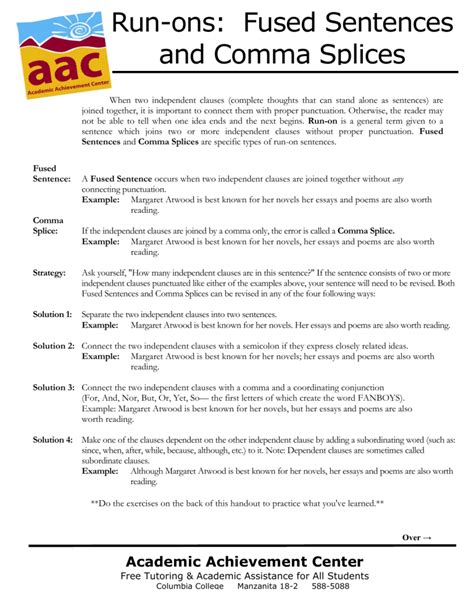The Importance of Punctuation in SAT Writing
Punctuation marks play a crucial role in conveying the intended meaning and structure of written text. In SAT writing, accurate punctuation is essential for earning high scores. By mastering the proper use of commas, semicolons, colons, dashes, and quotation marks, you can enhance clarity, eliminate grammatical errors, and demonstrate a strong command of the English language.

Comma Splicing: The Pitfall to Avoid
Comma splicing occurs when two independent clauses are joined by a comma instead of a period, semicolon, or coordinating conjunction (and, but, or, nor, for, so). This error results in a run-on sentence, which can be confusing and detract from the coherence of your writing.
Example of Comma Splicing:
- The SAT is a challenging exam, it requires extensive preparation.
Corrected:
- The SAT is a challenging exam. It requires extensive preparation.
Semicolons: The Versatile Separator
Semicolons can be used to separate two independent clauses that are closely related in meaning but lack a coordinating conjunction. They can also be used to separate items in a list when the items contain internal commas.
Example of Semicolon Use:
- The SAT consists of three sections; Reading, Writing and Language, and Math.
Colons: Introducing Supplementary Information
Colons are used to introduce lists, explanations, or direct quotations. They signal to the reader that important information is coming.
Example of Colon Use:
- The SAT Writing and Language section contains the following question types:
- Multiple choice
- Short answer
- Essay
Dashes: Emphasizing and Interrupting
Dashes can be used to emphasize words or phrases, indicate an interruption or change in thought, or to set off nonessential information.
Example of Dash Use:
- The SAT is not just a test—it’s a gateway to higher education.
Quotation Marks: Distinguishing Direct Speech
Quotation marks are used to enclose direct quotations, phrases, and titles of specific works. They indicate that the enclosed words are a direct reproduction of someone’s speech or writing.
Example of Quotation Mark Use:
- “The SAT,” said the guidance counselor, “is an important milestone in your academic journey.”
SAT Punctuation Practice (Using the Tag)
Practice Exercises
-
Comma Splicing: Correct the following comma-spliced sentences:
- The SAT is a challenging exam it requires extensive preparation.
- The test consists of three sections reading writing and language math.
-
Semicolon Use: Insert semicolons where necessary in the following sentences:
- The College Board offers the SAT it also offers the AP exams.
- The SAT essay prompt asks students to analyze a text it may also ask them to provide a personal perspective.
-
Colon Use: Rewrite the following sentences to include colons:
- The SAT Writing and Language section has three main question types multiple choice short answer essay.
- The test also includes an optional essay a student may choose to write it if they have extra time.
-
Dash Use: Add dashes where appropriate in the following sentences:
- The SAT is not just a test its a gateway to higher education.
- The counselor presented a valuable piece of advice be prepared for anything.
-
Quotation Mark Use: Insert quotation marks around direct quotes and titles in the following sentences:
- The guidance counselor emphasized the importance of the SAT.
- The test measures students skills in critical reading writing and math.
Tips for SAT Punctuation Mastery
- Read extensively: Familiarize yourself with the writing styles of different authors and styles.
- Review grammar rules: Study the conventions of punctuation and practice applying them.
- Use online resources: Utilize websites and apps that provide practice exercises and guided instruction.
- Seek feedback: Ask your teacher or a peer to review your writing and provide constructive criticism.
Additional Resources
Frequently Asked Questions (FAQs)
- How many punctuation marks are tested on the SAT? A total of 5 punctuation marks are tested: commas, semicolons, colons, dashes, and quotation marks.
- What percentage of SAT Writing and Language questions focus on punctuation? Approximately 20-30% of the questions on the SAT Writing and Language section test punctuation.
- What is the most common type of punctuation error on the SAT? Comma splicing is the most frequent type of punctuation error.
- How can I improve my punctuation skills for the SAT? Regularly practice identifying and correcting punctuation errors, use online resources, and seek feedback from others.
- Is there a formula for SAT punctuation? No, there is no specific formula for SAT punctuation. Proper punctuation requires an understanding of grammar rules and the ability to apply those rules in context.
- How long should I spend reviewing punctuation before the SAT? It is recommended to spend at least 3-4 hours reviewing punctuation before the SAT. This includes both studying grammar rules and completing practice exercises.
- What are some tips for avoiding punctuation errors on the SAT? Focus on clarity and coherence, read your writing out loud to identify any errors, and check for common punctuation pitfalls such as comma splices and run-on sentences.
- Is it enough to just memorize the rules of punctuation No, it is not sufficient to just memorize the rules of punctuation. It is important to understand how and when to apply those rules in different contexts.
